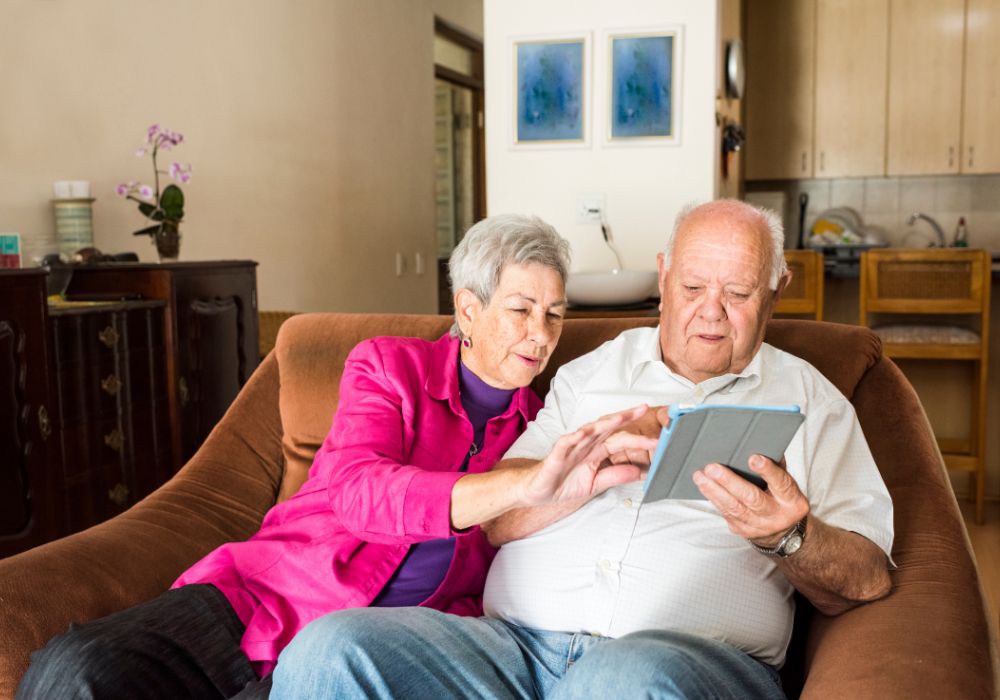
How to Help Seniors Stay Connected with Technology
Key Takeaways
Technology can significantly reduce social isolation in seniors, with video calling being the most impactful tool for maintaining meaningful connections with family and friends
A patient, step-by-step approach that focuses on one device or application at a time prevents overwhelming seniors and builds their confidence with technology
Senior-friendly devices with simplified interfaces, larger text, and intuitive navigation are worth the investment for long-term technology adoption
Regular practice sessions and creating a supportive learning environment are crucial for helping seniors retain new technology skills
Comfort Keepers Phoenix offers specialized technology assistance through trained caregivers who can help seniors stay connected in today's digital world
Why Is Technology So Important for Seniors' Well-being?
Technology has become a lifeline for seniors, particularly in combating social isolation. Research shows that seniors who use technology to stay connected experience lower rates of depression, better cognitive function, and report higher quality of life. The digital divide isn't just about access—it's about meaningful participation in family life and society.
Understanding the Digital Divide for Seniors
The term "digital divide" describes the gap between those who have ready access to computers and the internet, and those who do not. For many seniors, this divide represents more than just missing out on the latest gadgets—it represents disconnection from loved ones, limited access to information, and increased isolation.
According to the National Institute on Aging, approximately 42% of adults over 65 own smartphones, compared to 81% of adults aged 18-64. This gap widens further when considering more complex technologies or among seniors with physical limitations or cognitive challenges.
The consequences of this divide became painfully apparent during the COVID-19 pandemic, when in-person visits were restricted and technology became the primary means of connection. Seniors who couldn't navigate video calls or messaging platforms experienced profound isolation, highlighting the critical importance of technology literacy for older adults.
Several factors contribute to the digital divide among seniors:
Lack of exposure: Many of today's seniors grew up and worked in pre-digital environments, missing the gradual technology integration younger generations experienced
Physical limitations: Arthritis, vision impairments, and hearing loss can make standard devices challenging to use
Fear of making mistakes: Many seniors worry about breaking expensive equipment or falling victim to scams
Perceived complexity: Without proper guidance, technology can seem unnecessarily complicated
Cost concerns: Fixed incomes may limit access to devices and internet services
Lack of confidence: Previous negative experiences with technology can create resistance to trying again
Despite these challenges, the benefits of bridging this divide are substantial. Technology can help seniors maintain independence, access telehealth services, manage medications, stay mentally active, and most importantly, maintain social connections with family and friends regardless of physical distance.
The good news is that with proper support and guidance, seniors can overcome these barriers and embrace technology that enhances their quality of life. The key lies in understanding their unique needs and concerns, then providing patient, personalized assistance.
Common Technology Barriers for Seniors
1. Physical Limitations: As we age, physical changes can make standard technology challenging to use. Arthritis may make typing or swiping difficult, while vision changes can make small text hard to read. Hearing loss might make audio from devices difficult to understand. According to the Cleveland Clinic, more than 50% of adults over 75 experience some form of hearing loss, which can significantly impact their ability to use devices with audio components.
2. Cognitive Challenges: Learning new technology requires cognitive flexibility and memory—both of which can become more challenging with age. Remembering passwords, navigating multiple steps to complete a task, or understanding abstract concepts like cloud storage can be overwhelming. For seniors with mild cognitive impairment or early dementia, these challenges are amplified.
3. Fear and Anxiety: Many seniors express anxiety about using technology, often stemming from fear of making mistakes, breaking expensive equipment, or becoming victims of scams. This "tech anxiety" can create a significant psychological barrier. A study published in the Journal of Gerontology found that anxiety about technology use was one of the primary reasons seniors avoided adopting new devices, even when they recognized the potential benefits.
4. Lack of Relevant Training: Generic technology classes often fail to address seniors' specific needs and concerns. Instructions may move too quickly, use unfamiliar terminology, or focus on applications that don't align with seniors' interests. Without personalized guidance that connects technology to meaningful outcomes, many seniors struggle to see the relevance of learning these new skills.
Effective Strategies for Teaching Technology to Seniors
Strategy 1: Start with Meaningful Motivation Technology adoption is most successful when it connects to something the senior genuinely cares about. Before introducing any device or application, have a conversation about what would make technology worthwhile for them. Is it seeing grandchildren's faces during video calls? Accessing favorite books on an e-reader? Watching cooking tutorials? Playing brain games?
For example, Maria, 78, had little interest in learning to use a tablet until her caregiver discovered her passion for classical music. They set up a music streaming service with playlists of her favorite composers, which became Maria's gateway to other applications. Within months, she was confidently using email and video calls, motivated by her initial positive experience.
Implementation tips:
Identify specific benefits that resonate with the senior's interests and needs
Start with applications that deliver immediate, meaningful rewards
Use their personal motivations as examples when explaining features
Celebrate how technology enhances activities they already enjoy
Strategy 2: Choose Senior-Friendly Devices and Interfaces Not all technology is created equal when it comes to accessibility for seniors. Investing in the right devices can make a tremendous difference in successful adoption.
The GrandPad tablet, which Comfort Keepers offers, exemplifies senior-friendly design with its simplified interface, large buttons, and streamlined functions. Similarly, smartphones with "Easy Mode" settings, voice-activated smart speakers, and e-readers with adjustable text sizes can all provide more accessible entry points to technology.
For seniors with arthritis, stylus pens can make touchscreens more manageable. Those with vision impairments benefit from high-contrast displays and text-to-speech features. Hearing aids with Bluetooth connectivity can stream audio directly, making video calls more accessible for those with hearing loss.
Implementation tips:
Adjust accessibility settings on existing devices (larger text, higher contrast, voice commands)
Consider specialized devices designed specifically for seniors
Use external accessories like ergonomic keyboards or trackball mice if they help
Set up voice assistants like Alexa or Google Assistant for hands-free operation
Strategy 3: Use the "Bite-Sized" Teaching Approach One of the most common mistakes when helping seniors with technology is trying to cover too much at once. This overwhelms them and reinforces the belief that technology is too complicated.
Instead, break down learning into small, manageable sessions of 20-30 minutes, focusing on mastering one specific task at a time. For example, the first session might focus solely on turning the device on and off and adjusting the volume. The next might cover opening and closing a specific application.
Implementation tips:
Create a written step-by-step guide with screenshots for each task
Practice one skill repeatedly until it becomes comfortable before moving to the next
Use consistent terminology and avoid technical jargon
End each session with a small success to build confidence
Review previously learned skills at the start of each new session
Strategy 4: Embrace Repetition and Patience Learning new technology skills requires forming new neural pathways, which takes longer as we age. Research from the Mayo Clinic indicates that older adults may need to repeat new tasks 5-7 times more often than younger learners to achieve the same level of retention.
James, 83, needed to practice the steps for joining a video call eight times before feeling confident. His caregiver created a simple checklist and practiced with him three times a week. After a month, what once seemed impossible became routine, allowing James to join his church group's weekly virtual meetings independently.
Implementation tips:
Never rush the learning process or show frustration
Create memory aids like cheat sheets with clear, numbered steps
Use analogies that connect new concepts to familiar experiences
Schedule regular practice sessions, ideally at the senior's most alert time of day
Validate progress, no matter how small
When and How to Get Additional Technology Support
While family members and caregivers can provide valuable technology assistance, some situations call for additional support. Recognizing when to seek specialized help can prevent frustration and ensure seniors receive the guidance they need.
Consider seeking additional technology support when:
The senior has specific physical limitations requiring specialized adaptive equipment
Security concerns arise, such as potential scams or identity theft
Complex technology problems exceed your knowledge or troubleshooting abilities
The senior would benefit from structured classes or peer learning environments
You notice the senior becoming increasingly frustrated despite your best efforts
Many communities offer excellent resources specifically designed for seniors learning technology. Senior centers frequently host technology workshops tailored to older adults' learning styles, covering topics from basic smartphone use to internet safety. These group settings also provide valuable social interaction and peer support from others facing similar challenges.
Local libraries are another excellent resource, often offering free one-on-one technology assistance with patient staff members or volunteers. Many libraries also provide computer access and free Wi-Fi, allowing seniors to practice their skills in a supportive environment.
For seniors with physical limitations, occupational therapists can recommend specialized adaptive equipment and techniques for using technology despite arthritis, tremors, or vision impairments. These professionals can provide personalized strategies that address specific health challenges.
Online resources designed specifically for seniors include:
SeniorNet.org: Provides computer and internet education to older adults
AARP's Technology Resource Center: Offers tutorials, videos, and articles on various technologies
Cyber-Seniors.org: Connects seniors with student mentors for technology training
GetSetUp.io: Provides live classes on technology topics taught by seniors for seniors
When seeking additional support, keep these tips in mind:
Look for instructors experienced in teaching older adults
Verify that the pace of instruction is appropriate for seniors
Ensure the learning environment is physically comfortable and accessible
Confirm that handouts or resources are provided in large, readable print
Check that the focus is on practical applications rather than technical details
Remember that learning technology is a journey, not a destination. With the right support system in place, seniors can continue building their digital skills and confidence over time.
How Comfort Keepers Phoenix Can Help
At Comfort Keepers Phoenix, we understand that technology can be a powerful tool for enhancing seniors' quality of life and maintaining their vital connections to family, friends, and community. Our approach to technology assistance is guided by our core philosophy of Interactive Caregiving™, which focuses on engaging seniors as active participants in their care and daily activities.
Our specially trained caregivers provide personalized technology assistance that respects each senior's learning pace and specific needs. Rather than taking over and doing things for clients, our caregivers work alongside them, providing the guidance and support needed to build confidence and independence with technology.
Personalized Device Setup and Training Our caregivers can help set up and customize devices to accommodate vision, hearing, or dexterity challenges. We take the time to adjust settings like text size, screen brightness, and volume to create the most comfortable user experience. Then, we provide step-by-step training tailored to each senior's interests and abilities, focusing on the applications and features that will be most meaningful to them.
Regular Practice and Skill Building We understand that mastering technology requires consistent practice. Our caregivers can incorporate technology learning into regular care visits, providing the repetition needed to build confidence and competence. These practice sessions are always conducted with patience and positive reinforcement, celebrating each small success along the way.
Video Call Assistance Staying visually connected with family is often a top priority for seniors. Our caregivers can help schedule, set up, and facilitate video calls with loved ones, ensuring that technical difficulties don't get in the way of these important connections. For seniors who need extra support, caregivers can remain present during calls to assist with any technical issues that arise.
GrandPad® Support Comfort Keepers offers the innovative GrandPad® tablet, specifically designed for seniors with limited technology experience. This intuitive device features large buttons, a simple interface, and built-in cellular connectivity—no complicated Wi-Fi setup required. Our caregivers can help seniors make the most of their GrandPad®, using it for video calls, photo sharing, games, music, and more.
Online Safety Education We prioritize helping seniors stay safe online. Our caregivers provide guidance on creating strong passwords, recognizing potential scams, and protecting personal information. This education helps seniors enjoy the benefits of technology while minimizing risks.
Telehealth Appointment Support As telehealth becomes increasingly common, our caregivers can help seniors navigate virtual doctor appointments. From setting up the application to joining the call and taking notes, we ensure that technology enhances rather than hinders access to healthcare.
Social Media Guidance For seniors interested in social media, our caregivers can provide assistance in setting up accounts, connecting with family and friends, and understanding privacy settings. This opens up new avenues for social engagement and family connection.
Customized Learning Resources Our caregivers can create personalized reference guides with clear, large-print instructions for the specific tasks each senior wants to master. These guides serve as helpful reminders between caregiver visits, supporting independent technology use.
Beyond these specific services, what truly sets Comfort Keepers Phoenix apart is our caregivers' approach. We understand that technology is simply a means to an end—the real goal is enhancing connection, independence, and joy. Our caregivers focus on how technology can serve these deeper purposes in each senior's life.
All of our caregivers undergo rigorous screening and training, ensuring they have both the technical knowledge and the patience needed to support seniors effectively. They're selected not just for their skills but for their empathy, understanding, and genuine desire to make a positive difference in seniors' lives.
If you or a loved one could benefit from technology support that goes beyond basic instruction to foster meaningful connection, contact Comfort Keepers Phoenix today. Our care coordinators can answer your questions and help develop a personalized care plan that includes the technology assistance needed to stay connected in today's digital world. Together, we can bridge the digital divide and help seniors embrace the connections and opportunities that technology can provide.









